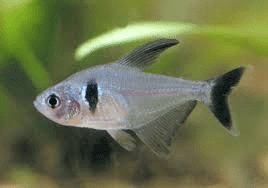
Common name: Black Phantom Tetra
Scientific name: Megalamphodus Megalopterus
Average Adult Fish Size: 1.75 inches / 4.5 cm
Place of Origin: Brazil, South America.
Typical Tank setup: Well planted with rocks and driftwood/bogwood. Tend to do better in dimmed lighting which could be achieved by introducing floating plants to the aquarium.
Recommended Minimum Aquarium Capacity: 15 gallon / 60 litre
Compatibility: It is very common to find tetras with Corydoras as companions, as they are both quite peaceful and other tank mates like Guppies, other Tetras, Rasboras, Mollies & Platies
Temperature: 72 – 82 Deg F / 22 – 28 Deg C
Water chemistry: pH 6.0 – 7.5
Feeding: Not fussy eaters and will accept most foods, primarily flake.
Sexing: Males have long black dorsal and pelvic fins and the females have shorter red coloured fins.
Breeding: For breeding a breeding tank needs to be set up (5 gallons is fine) and the PH lowered to 5.5 and the hardness of the water to 4 dGH. Condition a pair with live foods (white mosquito larvae works very well) and then place them into the breeding tank – the male will start a very elaborate mating dance and the female will release upto 300 eggs each spawn. Remove the pair as they will eat their own eggs. Fry can be fed with freshly hatched atermia and after ten days will accept finely crushed flake food.
Additional Information: They are very peaceful and make a beautiful addition to any community tank. They live for up to 5 years and if well fed can show stunning colours. A glittery sheen in males with the side spot truly shining in neon white – the males will often have little territorial dances with each other where they keep their dorsal and pelvic fins high up and erect and dance around each other, they do so in a peaceful manner and do not hurt each other. Preferably they should be kept with at least 10 with even numbers of males/females. They are not known to nip fins of other fish like other tetra’s.


Related Posts
Croaking Gourami – Trichopsis vittatus
Paradise Fish – Macropodus opercularis
Schubert’s Barb – Barbus Semifasciolatus